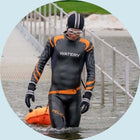In principle, you can swim in the sea all year round, but there are just certain times that are more suitable for practicing open water swimming than others. If you are training for competitions or simply want to spend longer periods in the water, there are several factors to consider. It primarily revolves around water temperatures, and related to these are considerations about attire, location, and time of year.
DMI's water temperature measurements 2019
Here you can see the average water temperatures and hence bathing temperatures in Denmark in 2019. As indicated, there can be significant differences from month to month. The same applies, of course, from year to year, but generally, the level remains relatively stable.
 If you find that the bathing temperatures in the summer months seem low, it's because these are averages. There are often days during the months when sea temperatures rise above 20 degrees celsius, but most of the time they remain below.
If you find that the bathing temperatures in the summer months seem low, it's because these are averages. There are often days during the months when sea temperatures rise above 20 degrees celsius, but most of the time they remain below.
Furthermore, there are regional differences, which can vary significantly from one another. The water temperature in Svendborg and Aarhus, for instance, might not necessarily be the same. You can read more about this and see illustrations further below.
Water temperature without a wetsuit
If you're accustomed to open water swimming, you certainly have one or two wetsuits lying around. They're indispensable. But when should you actually leave the wetsuit in the car? Opinions differ, but a good rule of thumb is that you don't need to wear your wetsuit in water above 20 degrees celsius.
The reason for this is that you'll quickly get too hot wearing it. You probably know it can be a bit cumbersome to constantly put on and take off the suit, so there's no need to use it unnecessarily. If you're stationary in the water, 20 degrees celsius might not necessarily feel too warm, but when you start swimming, it's a different story. Your sweat will quickly heat up your body to the point where it becomes uncomfortable, and then you'll need to remove the suit. Therefore, you might as well skip it entirely if we're fortunate enough that the water temperature reaches over 20 degrees celsius.

Here's an example of water temperatures in Denmark for a day in 2020. You can check the map here to see the current water temperature.
http://servlet.dmi.dk/vandstand/servlet/ImageServlet?type=Vandtemperatur&pres=Oversigt&stat=-&date=-.
As you can see, there's over a two-degree difference between the warmest and coldest places in Denmark, excluding Bornholm. Including Bornholm, the differences are even greater. Hence, the location where you practice open water swimming matters considerably. Some places tend to be warmer throughout the season than others. The warmest locations on this map indicate water temperatures in Helsingør, near Gedser, and around Lemvig, while the coldest spots are around Skagen and, of course, Bornholm.
Of course, you can't change where you live. However, you can pay attention to where you plan your vacation and in which waters any competitions are held. This way, you can prepare for the water you'll be swimming in and explore different bathing temperatures by traveling around the country.
The discount code can be used by all new customers on all products on the website, including the products recommended here in the article. What are you waiting for? Get more out of your time in and on the water!
GET A DISCOUNT CODE WITH 10% OFF
When is the water warm enough?
Again, this is somewhat subjective, but there are some general guidelines you can follow.
Below 5 degrees celsius
When the water is below 5 degrees celsius, it's simply too cold. Even with a wetsuit, you won't be able to endure it, and it will be an extremely unpleasant experience if you try. The cold water causes pain to the body, and you simply can't retain enough warmth to swim properly.
6-10 degrees celsius
It's still very cold, and it will be uncomfortable for the skin not covered by the wetsuit. However, you can still swim in it if you take the right precautions. It's a good idea to take breaks so that the exposed parts of your body can rest above the water.
You can be in water between 6 and 10 degrees celsius for 30 to 45 minutes. Beyond this time, it starts getting too cold to be safe.
11-14 degrees celsius
The water starts approaching temperatures suitable for swimming. It may still be painful for your hands and face initially, and you shouldn't spend several hours in the water. However, you can endure for about an hour or a bit more.
With proper preparation, bringing neoprene socks and a hood along with your suit, you can have a good experience in the water. It will still feel cold, but not as uncomfortably as at lower temperatures.
15-19 degrees celsius
Now it's no longer a big issue to take a plunge into the sea and swim away. Your body still needs to adjust, but once you're in, you can keep going for hours, especially if the sun is out.
The water now feels more refreshing than outright cold, as long as you're wearing your wetsuit. It might take a while, though, to regain warmth when you come out of the water. If you're sensitive to the cold, using neoprene socks is a good idea.
20 degrees celsius
As mentioned earlier, for most people, wearing a wetsuit becomes unnecessary at these temperatures. However, do what feels best for you. If you tend to feel cold, you can start with it on and remove it when it gets too warm.

Temperature and Attire
Here's an overview of the attire suitable for various water temperatures. As mentioned, you can swim in most conditions unless the water is extremely cold, but it's crucial to dress accordingly.
Low temperatures – 6 to 14 degrees celsius
You should dress really well in these conditions. Wear a good neoprene suit with a thick layer of neoprene, neoprene socks, a neoprene hood, and also neoprene gloves.
Additionally, it's a good idea to have larger swim goggles that protect you from the cold, and you can also consider wearing thermal underwear beneath your wetsuit. It might get wet, but it still creates a protective and warming layer since the wetsuit helps your body heat itself.
Moderate temperatures - 15 to 20 degrees celsius
Now, you don't need much other than your wetsuit. As mentioned, socks might also be good if you tend to feel cold. If you find it almost too warm when approaching 18-19 degrees celsius, consider a wetsuit with short arms and legs. This way, your torso stays warm with neoprene while the rest of your body directly contacts the water. It allows good mobility and helps if you start feeling too warm.
High temperatures – 20+ degrees celsius
As mentioned, most people can forgo the wetsuit at these temperatures. However, you can still use a wetsuit with short arms and legs if you don't feel the water is warm enough.
It's always a good idea to use a swim cap and swim goggles, regardless of water temperature. Primarily for technical reasons, but if you're accustomed to open water swimming or swimming in pools, you likely already know this.

Always be aware of hypothermia
Hypothermia can be life-threatening, so it's crucial to recognize its signs. It's a condition where your body temperature drops below 35 degrees celsius. It can go as low as 30 degrees celsius, which is the most severe and life-threatening stage.
The symptoms of hypothermia develop slowly and are characterized by slow speech and reduced ability to think clearly. Because it doesn't come suddenly, it can be challenging to detect, so at low water temperatures, it's always a risk that needs consideration.
Hypothermia affects the body as follows:
- Metabolism decreases
- You consume less oxygen and produce less carbon dioxide
- You stop shivering even though you still feel very cold
- The heart works less and less
- Pulse decreases
- Blood circulates slower in the body, increasing the risk of blood clots
- Finally, you stop breathing
It's an extremely dangerous condition that can lead to death. If you start experiencing symptoms while in the water, get out immediately. Never rub the body to warm it up, as it can lead to cardiac arrest. Instead, gradually warm up the body using clothing.
It can be dangerous to expose a person with hypothermia to sudden high heat because they might not necessarily feel burns. Therefore, it's recommended to slowly and safely raise the body temperature. Similarly, never attempt to warm the body using alcohol. It doesn't have a warming effect and can worsen the condition since it weakens the body, already weakened by cooling down.
If you engage in open water swimming at low temperatures, avoid staying in the water for too long. Additionally, wearing the right clothing, as suggested earlier, is a good safeguard from this dangerous condition.
How to safeguard from accidents
There are several risks associated with open water swimming compared to swimming in pools. However, it shouldn't deter you from taking a dip in the sea as long as you take the proper precautions.
Ensure you have the right equipment, and only buy wetsuits of good quality. Many online sell cheap suits from dubious websites, but it's not in your best interest to invest in those. There's no guarantee they'll function as they should. Therefore, it's much better to buy from established and reliable brands committed to ensuring you have a good and safe open water experience.
It's also crucial to monitor how long you stay in the water. Swimmers are often stubborn and willing to go the extra mile for better results. While that mindset is beneficial in many ways, it can be dangerous if taken too far. When swimming in open waters, always listen to your body. If it starts feeling like you can't handle more, get out. It's also essential to adhere to the recommended time intervals according to the water temperature. No one can withstand spending several hours in water at 10 degrees celsius, no matter how much competitive spirit we have.
Finally, you can prevent many mishaps by having a swimming buddy. You can support each other in your training, but most importantly, you can keep an eye on each other's well-being. Hypothermia is very hard to detect by yourself, so especially when temperatures are low, it's actually unsafe to go out alone. A buddy can remind you when it's time to leave the water, and of course, you can push each other's speeds in the water, benefiting each other. Perhaps you have a friend in your triathlon club, but if not, you can often find other open water swimmers online looking for a training partner. Once you've found your perfect open water companion, trying out lower temperatures suddenly feels much better when the water starts approaching 17-18 degrees celsius!





















